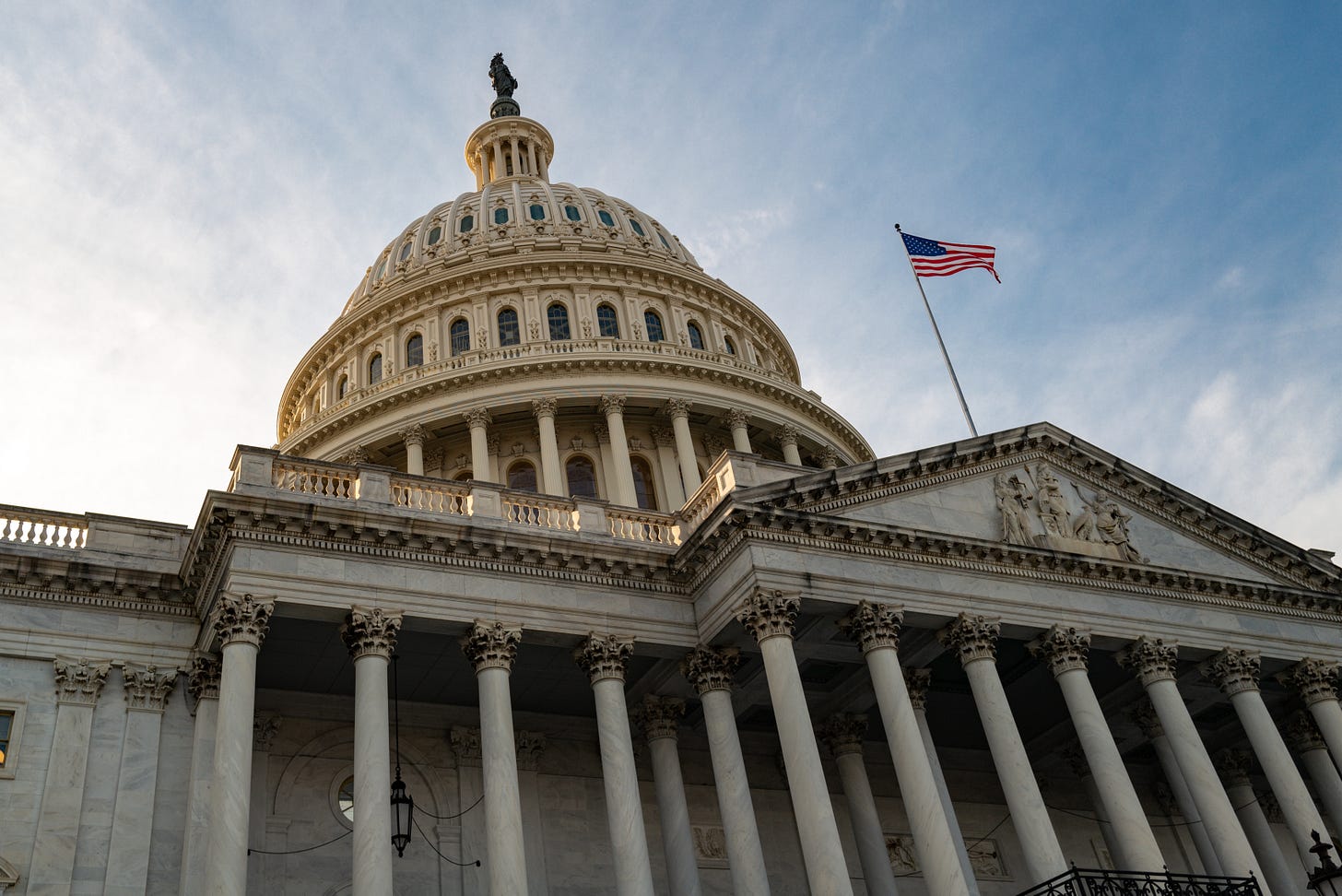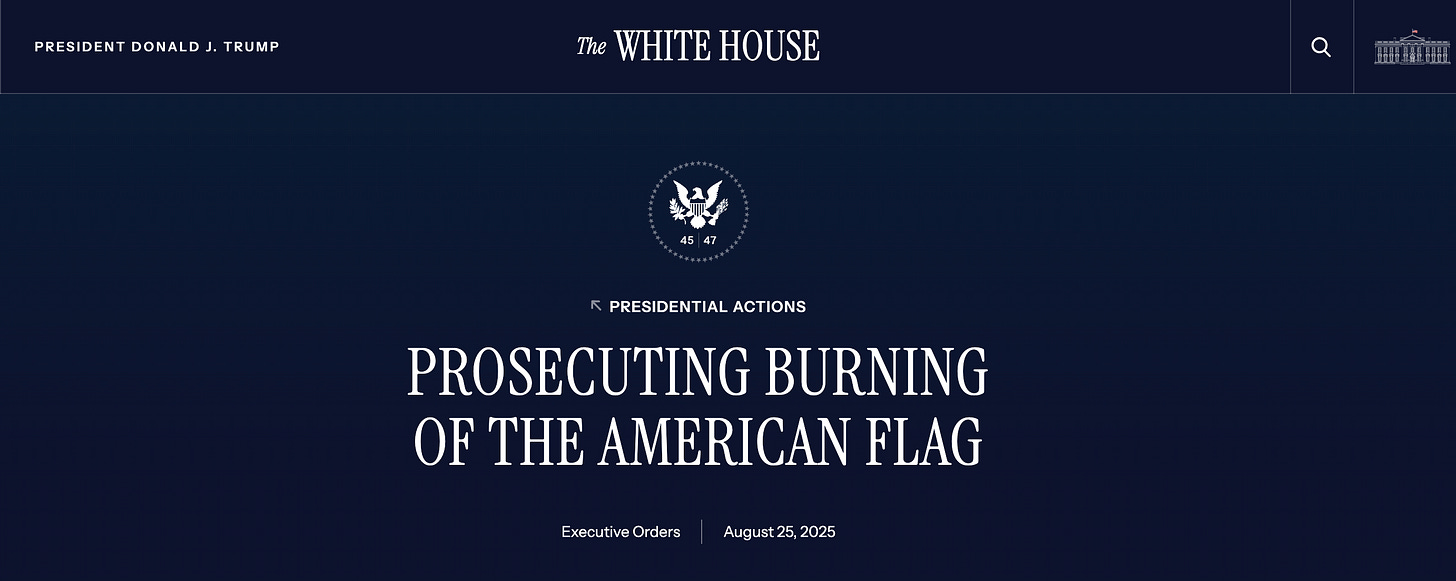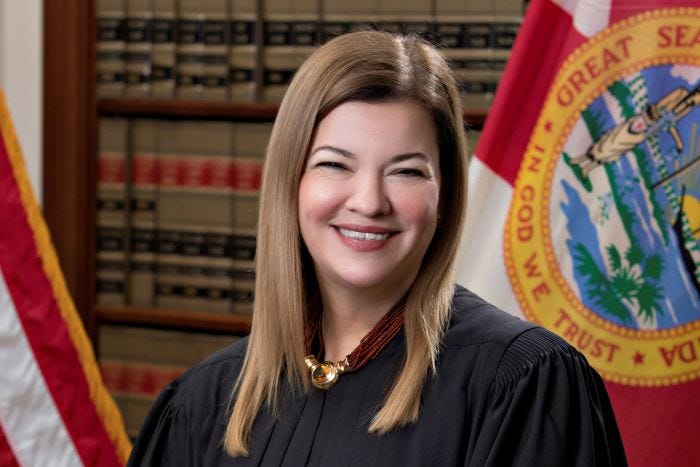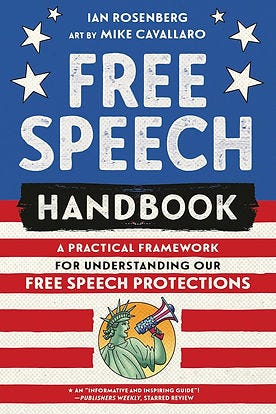Military ‘police’ forces in American cities: What that portends for political protests
First Amendment News 484

American colonists’ grievance: The King had “affected to render the Military independent of and superior to the Civil power.”
First, the National Guard and the Marines were deployed in Los Angeles, then the Guard occupied Washington, D.C., and next the Texas Guard will be headed for Chicago — albeit over the advance objection of the mayor.
All of this military presence is being ordered as an “anti-crime” initiative launched by our national police chief, President Donald Trump. Never mind whether this campaign is one of pretense, or is illegal, or is contravention of basic notions of federalism, or is being orchestrated as a vindictive crusade against Trump’s political adversaries — this though last January he issued an executive order calling for an end to all “systematic campaigns against…perceived political opponents, [and] weaponizing the legal force of numerous Federal law enforcement agencies.”
Beyond this political weaponization of military force and the disingenuous campaign to fight crime, the Trump campaign might also be preparing for a strong-arm military response to political protests. More about that in a moment.
A real ‘crime emergency’ or a sham one?
At the outset, consider Trump’s executive order of Aug. 25, 2025 (sect. 1 (d) (ii):
The Secretary of Defense shall immediately begin ensuring that each State’s Army National Guard and Air National Guard are resourced, trained, organized, and available to assist Federal, State, and local law enforcement in quelling civil disturbances and ensuring the public safety and order whenever the circumstances necessitate, as appropriate under law. In coordination with the respective adjutants general, the Secretary of Defense shall designate an appropriate number of each State’s trained National Guard members to be reasonably available for rapid mobilization for such purposes. In addition, the Secretary of Defense shall ensure the availability of a standing National Guard quick reaction force that shall be resourced, trained, and available for rapid nationwide deployment. (emphasis added).
Read those words carefully, and then consider how the Trump Administration might use such unchecked power to respond to so-called “civil disturbances.”
Might an uninhibited but peaceful protest rally be deemed a “civil disturbance” prompting a “rapid nationwide” military response? Might large crowds marching in unison be a “circumstance” that “necessitate[s]” military intervention? Though the Aug. 25 order is justified as a “Crime Emergency” measure related to the District of Columbia, what follows is neither limited to any alleged “crime” rage nor to the District of Columbia. Hardly, it applies to “each State” and “civil disturbances” as defined by the Justice Department.
Authorized by law?
Before saying more, note the targeted use of the military and Trump’s purported justification for fighting crime. The question here — and one relevant to protecting free expression — is whether the President is authorized to act as he asserts.
The federal statute the government relies upon to send troops into Illinois (or any other state) does not authorize the kind of federal military involvement claimed by the administration. As Professor Stephen Vladeck has observed: “the [statutory] provision authorizes the President or Secretary of Defense to request (not require) governors to volunteer members of their National Guards, again, without those troops being federalized, to support federal missions.”
Next, and by analogy, the administration violated the Posse Comitatus Act through some of its military deployments in and around Los Angeles as Judge Breyer recently ruled in Newsom v. Trump.
Moreover, and again as Judge Breyer observed in the Newsom case, there was no showing of “rebellion, nor was civilian law enforcement unable to respond to the protests and enforce the law.”
Finally, any true concern about fighting crime is called into question by the fact that Trump is “only deploying troops to blue cities when most of the dangerous cities are in red states.”
Use of military power to suppress protests
To unlawfully turn cities into military zones also raises serious First Amendment issues when it comes to civil protest.
As Professor
has pointed out:It is important to remember that all this started with public protests concerning aggressive immigration raids by the Department of Homeland Security and ICE.” Furthermore, the “Trump Administration would like nothing more than to be able to police public protests with federalized or active-duty military personnel. During his first term, President Trump expressly communicated that desire and, in addition, suggested to his Defense Secretary that protesters in D.C. should be shot in the leg by military personnel.
Such unauthorized military presence only serves to escalate tensions when protests occur, especially when they are as selective and punitive as previously employed by the first Trump administration.
New scholarly article on public protests and civil unrest
Timothy Zick, “Public Protest and Civil Unrest,” Arizona Law Review (2025)
Governments and officials must respond to protest-related civil unrest. How they do so is both an index of official respect for dissent and a measure of how committed governments are to democratic accountability. This Article examines official responses to civil unrest in connection with several recent high-profile demonstrations. In general, it concludes that governments and officials have relied on aggressive and increasingly draconian measures to quell protest-related civil unrest. Among other things, they have invoked emergency powers and used aggressive protest policing methods; dispatched federal agency personnel and threatened to deploy military forces to police demonstrations; enacted successive waves of laws that broaden riot offenses, increase penalties for minor offenses and acts of civil disobedience, and restrict campus protest; and charged protesters with domestic terrorism and racketeering. Officials have an obligation to maintain public order and safety. However, the recent pattern constitutes troubling evidence of democratic backsliding.
Both contemporaneous and subsequent responses to protest-related civil unrest jeopardize even lawful public protest, disproportionately punish acts of civil disobedience, and imperil a long tradition of campus activism.
In response, the Article offers a broad reform agenda that includes demystifying the government's emergency powers, de-escalating protest policing, de-federalizing responses to local unrest, considering the proportionality of charges and sanctions for protest-related offenses, preserving campus protest, and ensuring neutral and consistent responses to protest-related civil unrest.
Related
- , “Militarizing Protests and Free Expression,” Thoughts on the First (Sept. 2)
“Deploying National Guard and other military troops to respond to protest-related civil unrest will undermine First Amendment rights.”
FIRE on flag-burning executive order
On Aug. 25, President Donald Trump issued an executive order cracking down on flag burning, which is protected expressive activity under the First Amendment. During the signing, Trump remarked, “If you burn a flag, you get one year in jail.” The following statement can be attributed to FIRE Chief Counsel Bob Corn-Revere.
President Trump may believe he has the power to revise the First Amendment with the stroke of a pen, but he doesn’t.
Flag burning as a form of political protest is protected by the First Amendment. That’s nothing new. While people can be prosecuted for burning anything in a place where they aren’t allowed to set fires, the government can’t prosecute protected expressive activity — even if many Americans, including the president, find it “uniquely offensive and provocative.”
You don’t have to like flag burning. You can condemn it, debate it, or hoist your own flag even higher. The beauty of free speech is that you get to express your opinions, even if others don’t like what you have to say.
Related
Adam Liptak, “He Burned a Flag and Won an American Right. He Worries It’s at Risk,” The New York Times (Sept. 1)
Big Tech Censorship Forum
“The Antitrust Division Hosts a Big-Tech Censorship Forum,” Dept. of Justice, Office of Public Affairs (April 3, 2025)
The Antitrust Division hosted a discussion on the implications of Big-Tech censorship focusing on the impact of deplatforming on public discourse and how monopolization contributes to the ability of big tech companies to censor Americans.
New judicial attack on NYT v. Sullivan
Eugene Volokh, “Judge Barbara Lagoa (11th Cir.) Criticizes New York Times v. Sullivan,” The Volokh Conspiracy (Sept. 2)
From Judge [Barbara] Lagoa’s concurrence in Friday’s Dershowitz v. CNN, Inc. (and see also Judge Charles Wilson's concurrence taking the opposite view):
In New York Times, Inc. v. Sullivan, the Court usurped control over [the] field of speech-related torts and invented “a federal rule that prohibits a public official from recovering damages for a defamatory falsehood relating to his official conduct unless he proves that the statement was made with ‘actual malice’ — that is, with knowledge that it was false or with reckless disregard of whether it was false or not.” Three years later, this same rule was extended to “public figures” in addition to public officials… [In 1974,] the Court held for the first time that falsity and harm were not enough, and even private plaintiffs must show some sort of ‘fault,’ negligence at the least, to recover for defamation. And, even with that proof of culpable fault, damages were not presumed but had to be proven… [and] no plaintiff could recover punitive damages for defamation without showing Sullivan-style malice. With this series of cases… one generation of the Supreme Court succeeded in imposing federal constitutional limitations (seemingly untethered to the Constitution’s original meaning) on all defamation claims brought by all manner of plaintiffs. . .
Related
Eugene Volokh, “Judge Charles Wilson (11th Cir.) Defends New York Times v. Sullivan,” The Volokh Conspiracy (Sept. 2)
Eugene Volokh, “Alan Dershowitz's Libel Case Over CNN's Coverage of His Defense in Trump Impeachment Thrown Out,” The Volokh Conspiracy (Sept. 2)
New book: Rosenberg’s Free Speech Handbook
Ian Rosenberg, “Free Speech Handbook: A Practical Framework for Understanding Our Free Speech Protections” (23rd St., 2025)
In the face of a rising tide of censorship and suppression, this paperback edition of Free Speech Handbook equips readers with a practical framework for appreciating the history ― and future ― of our free speech protections.
Freedom of speech is perhaps the most American of virtues. In a nation where everyone wants to speak and be heard, this First Amendment right is vital to our identity and our democracy. These rights have been advanced by people who spoke out and fought in our nation’s highest court, with each decision refining and reshaping what exactly “free speech” means.
In Free Speech Handbook, Ian Rosenberg and Mike Cavallaro brilliantly trace this turbulent history across ten seminal Supreme Court cases while drawing parallels with more recent controversies. Rosenberg’s straightforward language combines with Cavallaro’s bold and bright art to create an accessible and engaging crash course on the meaning, reach, and limits of our free speech protections.
podcast: Barbas on hate speech
“Civil rights, hate speech, and the First Amendment,”
(Aug. 28)
We know the First Amendment protects hate speech. But has it always done so? And how have civil rights groups responded when their members are the target of hate speech?
Sample recent articles from The Volokh Conspiracy blog
Eugene Volokh, “Injunction Enforcing Anti-Disparagement Contract Provision Doesn’t Violate First Amendment,” The Volokh Conspiracy (Sept. 2)
Josh Blackman, “Grand Jury Nullification in the District of Columbia?” The Volokh Conspiracy (Aug. 30)
Eugene Volokh, “Death Doulas Have First Amendment Right to Advise Clients Without Having to Get Funeral Services License,” The Volokh Conspiracy (Aug. 29)
Eugene Volokh, “California Law Restricting ‘Materially Deceptive’ Election-Related Deepfakes Violates First Amendment,” The Volokh Conspiracy (Aug. 29)
More in the news
Dave Ross, “The Volatile History of Flag Burning in the US,” History (Sept. 2)
Stephany Matat, “Florida orders cities to erase street art, sparking free speech debate,” Tallahassee Democrat (Sept. 2)
“Judge Throws Out Campaign Finance Lawsuit Between Republican Rivals in Georgia Governor’s Race,” First Amendment Watch (Aug. 29)
“FIRE statement on UT-Dallas student newspaper distribution,” FIRE (Aug. 29)
David Bauder, “Defamation case against Fox News highlights role of its hosts in promoting 2020 election falsehoods,” Free Speech Center (Aug. 28)
“VICTORY! University of North Texas system lifts drag ‘pause’ after FIRE/ACLU of TX letter,” FIRE (Aug. 28)
“Trump’s Order on Flag Burning Could Return the Question to the Supreme Court,” First Amendment Watch (Aug. 27)
Emma Colton, “Trump flag burning executive order could flip First Amendment on its head with new court,” Fox News (Aug. 25)
“Report: Record Number of States Now Protect Free Speech from Frivolous Lawsuits,” Institute for Free Speech (Aug. 25)
2024-2025 SCOTUS term: Free expression and related cases
Cases decided
Villarreal v. Alaniz (Petition granted. Judgment vacated and case remanded for further consideration in light of Gonzalez v. Trevino, 602 U. S. ___ (2024) (per curiam))
Murphy v. Schmitt (“The petition for a writ of certiorari is granted. The judgment is vacated, and the case is remanded to the United States Court of Appeals for the Eighth Circuit for further consideration in light of Gonzalez v. Trevino, 602 U. S. ___ (2024) (per curiam).”)
TikTok Inc. and ByteDance Ltd v. Garland (9-0: The challenged provisions of the Protecting Americans from Foreign Adversary Controlled Applications Act do not violate petitioners’ First Amendment rights.)
Cases for Next Term
Pending petitions
Petitions denied
MacRae v. Mattos (Thomas, J., special opinion)
L.M. v. Town of Middleborough (Thomas, J. dissenting, Alito, J., dissenting)
No on E, San Franciscans Opposing the Affordable Care Housing Production Act, et al. v. Chiu
Emergency Applications
Netchoice v. Fitch (emergency relief denied with Kavanaugh, J., concurring with separate opinion: “I concur in the Court’s denial of NetChoice’s application for interim relief because NetChoice has not sufficiently demonstrated that the balance of harms and equities favors it at this time… To be clear, NetChoice has, in my view, demonstrated that it is likely to succeed on the merits — namely, that enforcement of the Mississippi law would likely violate its members’ First Amendment rights under this Court’s precedents.”)
Yost v. Ohio Attorney General (Kavanaugh, J., “IT IS ORDERED that the March 14, 2025, order of the United States District Court for the Southern District of Ohio, case No. 2:24-cv-1401, is hereby stayed pending further order of the undersigned order of the Court. It is further ordered that a response to the application be filed on or before Wednesday, April 16, 2025, by 5 p.m. (EDT).”)
Free speech-related
Mahmoud v. Taylor (argued April 22 / free exercise case: issue: Whether public schools burden parents’ religious exercise when they compel elementary school children to participate in instruction on gender and sexuality against their parents’ religious convictions and without notice or opportunity to opt out.)
Thompson v. United States (decided: 3-21-25/ 9-0 with special concurrences by Alito and Jackson) (interpretation of 18 U. S. C. §1014 re “false statements”)
Last scheduled FAN
Muzzling Museums: Trump’s chilling threats persist
“It’s a new, beautiful, Smithsonian Museum that serves as a shining example of African Americans’ incredible contribution to our culture, our society, and our history.”
This article is part of First Amendment News, an editorially independent publication edited by Ronald K. L. Collins and hosted by FIRE as part of our mission to educate the public about First Amendment issues. The opinions expressed are those of the article’s author(s) and may not reflect the opinions of FIRE.






